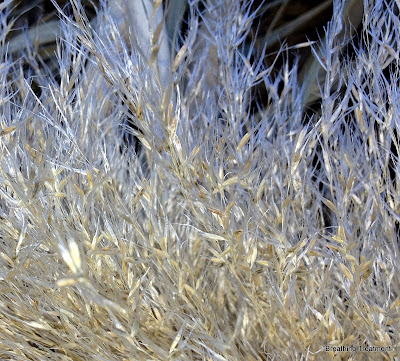I started reading about Pampas grass (Cortaderia selloana), and then quickly decided that I really ought to be reading about Jubata grass (Cortaderia jubata). Both are undesirable invasive weeds along the California coast, but Jubata grass is more widespread.
According to Cal-IPC one way to discriminate is by pannicle (flower) height.
Jubata grass (Cortadaria jubata) is a perennial grass six to twenty-three feet tall with long leaves arising from a tufted base or tussock. The inflorescence or flower cluster is a plumed panicle at the end of a long stem. Stems generally are at least twice as long as the tussock. Plumes consist of hairy female flowers, deep violet when immature, turning pinkish or tawny cream-white at maturity. Jubata grass is easily confused with, and often called, pampas grass (Cortaderia selloana). The two species are distinguished by stem height, leaf, plume, and spikelet color, florets, leaf tip, and presence of viable seed. The tussocks of jubata grass are less erect and more spreading and not fountain-like, when compared to tussocks of Cortaderia selloana.
I think I've got Jubata in the picture above, based on the significantly higher pannicles than the tussock.
An individual inflorescence can produce 100,000 minute seeds (Harradine 1991), and large clumps can produce a million or more seeds (Cowan 1976)...
Reproduction of jubata grass is by asexual means only. Flowers typically are produced from late July to September (Madison 1992), even in the first year of growth. Plants can flower twice during the same season. Although all plants produce only female flowers, viable seeds develop from unfertilized ovules (apomixis). No pollination is necessary. All seedlings are genetically identical to the parent plant. This unusual form of reproduction is probably the most important characteristic responsible for the weediness of jubata grass, as well as its limited range. An individual inflorescence can produce 100,000 minute seeds (Harradine 1991), and large clumps can produce a million or more seeds (Cowan 1976).
Seeds do not appear to survive long in the soil, although no detailed studies have yet been conducted.
Check out the seeds on this one pannicle:
More from Cal-IPC:
Jubata grass is native to northern Argentina and the Andes of Bolivia, Peru, Chile, and Ecuador (Costas-Lippmann 1977). In its native range it can be found from sea level to elevations greater than 11,000 feet (3,400 m). It was first cultivated in France and Ireland from seed collected in Ecuador (Costas-Lippmann 1977). It is not clear how or when it was introduced into California, but it may have come through France via the horticultural trade (Madison 1992).
Jubata grass was first reported as a weed in California in logged redwood forests of Humboldt County in 1966 (Fuller 1976). Since infestations exist only in coastal areas of California, it is likely that the origin of this weed is a low-elevation biotype from South America. Because all seed production occurs without pollen transfer (apomictic), little genetic diversity exists within these plants (Connor 1973). This would explain its limited range in California. Spread occurs by wind-blown seed or by humans using mature inflorescences in decorative arrangements or using plants in landscaping. Seeds have been reported to disperse over twenty miles under windy conditions (Gadgil et al. 1984). Movement throughout the state also occurs when nurseries mistakenly sell this weedy species instead of Cortaderia selloana (Madison 1992).
I'll hazard a guess that there's almost a whole masters thesis in botanic history right there. 20 miles to move some seeds is a HUGE distance. More about that later.
You can see why people like them at this time of year.
But I prefer them shaven.
I spent maybe four hours trimming this one in Lunada Canyon (use a pole trimmer after you've sheared the sides to avoid the razor like edges of the leaves) in order to reduce its possible spread.
Meanwhile some fool on E-bay is selling "HEIRLOOM NON GMO Pink Pampas Grass 10 Seeds FREE SHIPPING". Hopefully no one in California is buying.





No comments:
Post a Comment